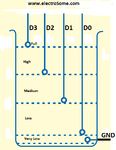misnomerfrenzy
Junior Member level 1
Hello,
Que 1: -
I am building circuit for Water Level Controller. On microcontroller side, my requirement will be to use 3 I/O pins (Low, high and overflow levels of water in tank) and a UART for RS485 communication.
My first choice will be Microchip 12F, 10F controllers. I have browsed through the Microchip search engine to get the microcontroller which will suit my requirement.
Could you help me by suggesting me a cheapest microcontroller which has 3 I/O pins, a UART and possibly an 8 bit timer.
Que 2: -
To choose sensor for Water level controller
I have read various posts related to above topic regarding selection of sensor. I got to know that normal wire, copper rod, steel or iron rod can't be used for long term as they undergo oxidation in water.
I also read that instead of the DC signal, and AC should be used to detect water level.
The connection arrangement is similar to that of attached image.
Could you please tell me which are the cheap and long lasting sensors, I should use for this project? Is it necessary to go for AC signal to avoid corrosion of sensor?
Que 1: -
I am building circuit for Water Level Controller. On microcontroller side, my requirement will be to use 3 I/O pins (Low, high and overflow levels of water in tank) and a UART for RS485 communication.
My first choice will be Microchip 12F, 10F controllers. I have browsed through the Microchip search engine to get the microcontroller which will suit my requirement.
Could you help me by suggesting me a cheapest microcontroller which has 3 I/O pins, a UART and possibly an 8 bit timer.
Que 2: -
To choose sensor for Water level controller
I have read various posts related to above topic regarding selection of sensor. I got to know that normal wire, copper rod, steel or iron rod can't be used for long term as they undergo oxidation in water.
I also read that instead of the DC signal, and AC should be used to detect water level.
The connection arrangement is similar to that of attached image.
Could you please tell me which are the cheap and long lasting sensors, I should use for this project? Is it necessary to go for AC signal to avoid corrosion of sensor?
